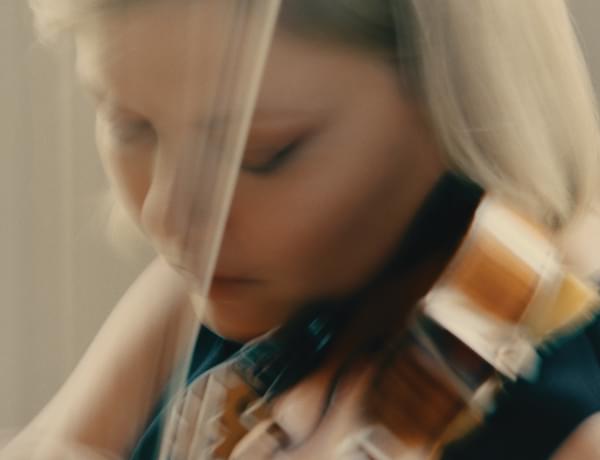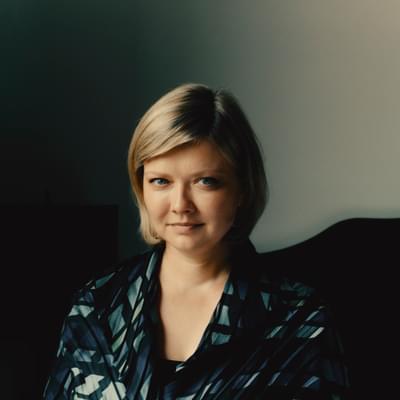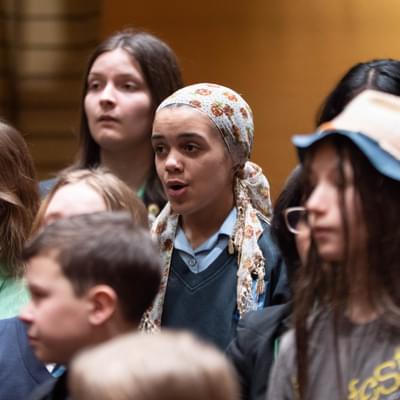Sibelius & Dvořák

Full programme
- Arvo Pärt, Our Garden (Cantata for Children’s Chorus and Orchestra) (12mins)
- Sibelius, Violin Concerto (35mins)
- Dvořák, Symphony No.8 (34mins)
Performers

Dinis Sousa
Conductor
Alina Ibragimova
Violin
CBSO Youth Chorus
Introduction
Despite having been to Birmingham before, I’ve never had the pleasure to work with the City of Birmingham Symphony Orchestra – in fact, I’ve never even heard the orchestra live, only in recordings! So I’m really excited for this concert, particularly as I love the programme we will be presenting to you.
I fell in love with Dvořák’s Eighth Symphony a few years ago – I remember first thinking that it was a bit over the top but when I eventually came to conduct it, I completely fell in love. It is, of course, big and boisterous but there’s so much more to it. I quickly started to appreciate just how much subtlety, imagination and creativity there is in it.
It’s a piece that is very close to my heart and I find it incredibly moving to conduct. When the theme of the last movement returns at the end, just before the piece explodes into its coda, it always brings me close to tears. There’s a real sense of nostalgia in the symphony throughout – Dvořák has this way of writing music that is, on one hand, completely celebratory and exciting, whilst often looking back and it makes me, personally, very nostalgic.
Sibelius’ Violin Concerto was the first of Sibelius’ pieces that I had ever conducted. His music is so unusual and unlike anything else. I remember my first reaction when I started studying it was of shock at the unusual way in which he writes music, which often looks more complicated than it sounds. But I quickly got over it as it’s such overwhelming music. As with Dvořák, there are opposing sides to his music, in this case a juxtaposition coldness and warmth throughout the piece. It starts with this distant, icy landscape, but the second movement is so glorious and generous, and there are some really epic moments for the orchestra. Alina Ibragimova joins us on stage for this piece – we’ve known each other for many years but have never done a concert together! She’s a phenomenal musician and I can’t wait to perform this piece with her.
The Arvo Pärt piece is new to me – it’s very rare to see it programmed but when I came across it, I felt it would fit perfectly in this programme; it’s very charming, sweet and not like the rest of Pärt’s music that I know. He wrote it when he was still a student and it’s extremely colourful yet innocent, with some folk influences too.
I hope you enjoy this evening’s concert and connect to the pieces as much as I do. I am currently conducting a three-month run of Mozart’s Così fan tutte with Graz Opera so I am really looking forward to breaking from the opera patch to join you for this concert!
Dinis Sousa
Conductor
Programme notes
Arvo Pärt’s Our Garden is a cheerful wonderland of activity, brought to joyful life by the CBSO Youth Chorus. Nobody could evoke a Finlandian winter like Sibelius – shiver with the brilliant Alina Ibragimova in his Violin Concerto. Dvořák’s cheerful Symphony No.8 is a parade of one terrific tune after another, conducted by Dinis Sousa.
Our Garden
Arvo Pärt (b. 1935)
Arvo Pärt’s cantata Our Garden was the composer’s winning entry for a Soviet competition in 1962, but it had been composed three years earlier. As Estonian archivist Karin Rõngelep notes, Pärt’s more experimental music had been regarded with some suspicion by the authorities; by contrast, this cantata, with its wholesome verses about gardening, met with their approval. However, as Rõngelep further points out, Eno Raud’s text manages to be gently subversive nonetheless. It does not glorify the regime as such, but rather celebrates playful interactions with the animal kingdom and the joys of picking fruit.
It is in four verses, each with a contagiously good-humoured batch of melodies. The first includes some light-hearted imitations of bees, while the second has a kind of sun-drenched languor, brought about by the thorny business of weeding in the hot weather. Birds are chased away in the spirited third movement, which has some intriguing brass and percussion effects evoking the eerie figure of the scarecrow. After a chorale-like introduction and a rather magical passage for strings and harp (portraying a ‘sea of apples’), the music of the first movement returns, and with it a brief paean to the homeland.
Violin Concerto
Jean Sibelius (1865-1957)
Sibelius was a mass of contradictions: he was a hard-worker, yet frequently given to extravagant drinking and dining; he was a family man (fathering six daughters with his wife Aino), yet the marriage was stormy due to Sibelius’s frequent absences, hard-living, and over-spending. Around the time the composer was working on his Violin Concerto (which he completed in 1904) he was spending most of his time in drinking establishments in Helsinki, and behaving badly towards colleagues and friends (he promised his Violin Concerto’s premiere and dedication to Willy Burmester, but gave him neither). As a result of all this, his wife and friends staged something of an intervention, arranging for a new family home to be built in the in the middle of the forest at Järvenpää, where Sibelius would live and work for the rest of his life.
The Concerto itself is also a – somewhat more edifying - fusion of contradictions. It is very much a soloist’s concerto (Sibelius was himself a violinist) yet its extraordinary passages of virtuosity are not for the sake of exhibitionism but rather to participate in a struggle with the orchestra which is given passages of monumental force. As violinist Stefan Jackiw puts it ‘there is a craggy cruelty in the orchestral part and in the Finnish landscape…The whole piece is about losing control to nature and just being consumed and devoured by it.’
The opening bars certainly suggest an icy, forbidding environment into which the violinist arrives with a tradition-defying passage of play. The lengthy opening solo is full of twists and turns as the soloist tries out scraps of melody, periodically coming to a halt, then starting again. Other instruments gradually join from the sidelines, including woodwind and a soft, yet ominous rumble from the timpani. After a surprising mini-cadenza from the soloist, silencing the band, the orchestra rejoins for a gloriously romantic sequence. Yet shortly after, the violinist then launches into its full cadenza, riffing on themes already heard. Convention has it that the soloist gets a break after this, but Sibelius instead has the violinist continue to tussle with the orchestra, insistently running through melodies from the opening. The orchestra finally gets a chance to flex its ‘craggy’ muscles – and how - before reprising the romantic passage from earlier. Both soloist and ensemble end, however, in a fiery exchange, each attempting to dominate the other.
The slow movement is heart-rending, characterised by long, wistful melodies and sensitive scoring for pairs of woodwind instruments. A passage towards the end, where rising scales in the solo violin are mirrored by falling notes in the flutes and strings, is particularly ravishing. The finale was memorably described by the musicologist Donald Tovey as ‘a polonaise for polar bears’. There is indeed a wrong-footed, occasionally comical side to the leaping melody, but the slightly drunken nature of the opening salvo – with its discordant lurches and tumbles - may have more to do with Sibelius’s nights in Helsinki bars. Later on in the movement, the soloist slips and slides on harmonics, high above the rest of the ensemble. The violinist’s recklessly freewheeling style manages – just about – to keep a step ahead of the orchestra. It ends with a fabulous, bravura display.
Symphony No.8
Antonín Dvořák (1814-1904)
It is tempting, when writing a note about a symphony like Dvořák’s eighth, simply to say ‘sit back and enjoy’. For it really is one of the most purely agreeable pieces, written not to challenge the listener or the symphonic form, but to be experienced for the delight that it is. It was composed in 1889 in the peaceful surroundings of the composer’s summer home in Vysoká, about 50 miles west of Prague. As Klaus Döge has pointed out, there is a poetic, even visual quality to Symphony no. 8, with its evocations of bird calls, folksong and fanfares – a marked contrast to the turbulence of Symphony no. 7. But above all, it is simply abundant with melody.
This is the case right from the opening bar. Dvořák launches straight into the first of many memorable and well-crafted tunes, this one described by his biographer Otakar Šourek as ‘festively grave’. A solo flute then introduces a bird-like theme, landing on an unusually sustained high note (presumably sharing the breathing duties with a fellow flautist) while the orchestra gathers itself beneath. The brass raucously imitates the birdsong in their own style before another theme emerges, followed by yet another, and so on, and all cheerfully commented on from on high by the birds (or flutes). The themes are occasionally given sterner treatment, but generally an atmosphere of high spirits prevails until the end of the movement. The horns in particular have a good time in the final bars.
Much of the material of the second movement grows from the upward group of four notes heard in the first bar. This figure, subtly transformed each time, introduces nearly all the subsequent melodies, including a surprisingly sultry one for clarinets. As in the first movement the mood shifts at times, from occasionally sombre to mostly sprightly, and often heralded by a rumble from the timpani. The third movement is charm itself, framed by a whirling waltz that manages to be both graceful and melancholy. The central Scherzo section is outdoorsy and folk-like, a little off-kilter in its accompaniment (with the timpani making its presence felt again) which gives a slight edge to its otherwise sunny melody.
In the finale Dvořák weaves a set of variations around the principal theme, first heard after a declamatory trumpet fanfare. Each variation takes on a different character – an expanded version of the technique Dvořák employed in the second movement – sometimes speeding up the tempo, or reducing the orchestral forces, maybe letting the horns go wild with a high-pitched trill. A folk-like theme emerges, which seems to be entirely different, yet has the same rhythmic outline as the opening, followed by further variations on itself. For the rest of the movement Dvořák dips in and out of this rich network of themes, including call-backs to the opening fanfare. The movement closes with an outrageously good-natured caper to the end. The last chord, landing surprisingly on the second beat of the bar, is a gleeful final joke.
© Lucy Walker